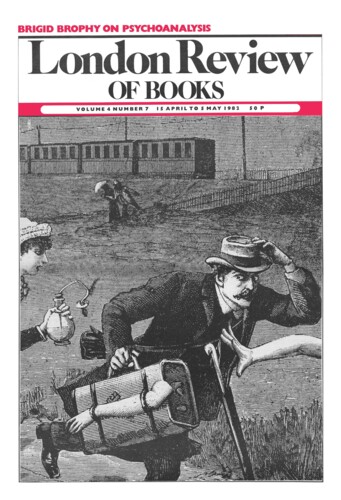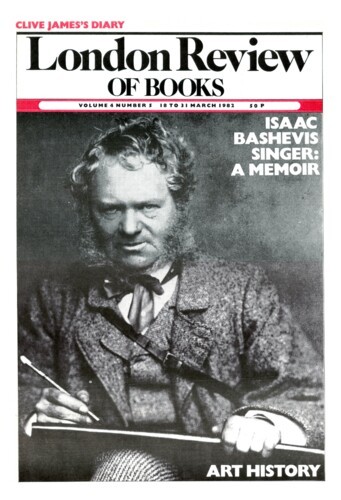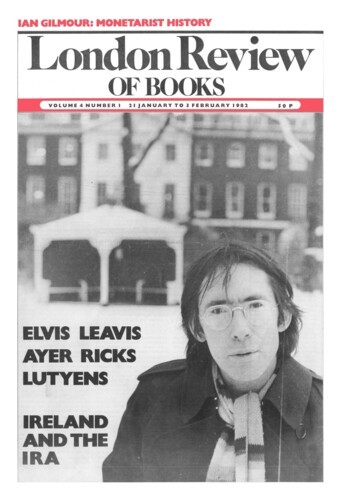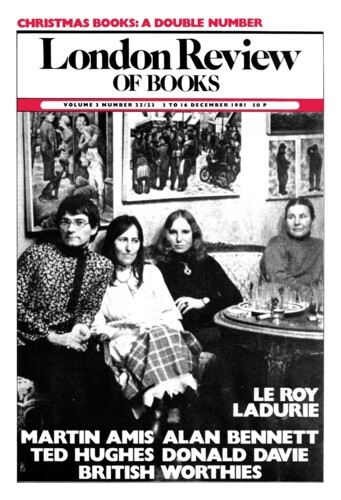David Cannadine
David Cannadine, who teaches at Princeton, is president of the British Academy and editor of the Oxford Dictionary of National Biography. His books include The Decline and Fall of the British Aristocracy and Victorious Century: The United Kingdom 1800-1906.
Thoughts on the New Economic History
David Cannadine, 15 April 1982
The covers of two of these books display very similar views of Manchester, the ‘shock city’ of early 19th-century England. One is for 1836 and the other for 1851, and both embody a familiar picture of the Industrial Revolution: of factories pouring out goods, and chimneys belching forth smoke; of burgeoning exports, spiralling output and rising productivity; and of improved land, unceasing labour, accumulating capital and inspired enterprise. Here is an epic drama: Coketown in the making, the workshop of the world in operation, and the factors of production in fertile fusion. Taken together, these two illustrations project an image of the Industrial Revolution as an heroic happening, characterised by vigour, energy, inventiveness and courage, or (depending on your point of view) by exploitation, cruelty, avarice and shame. Either way, to look at these pictures, to visualise the events which they capture for a moment, and to imagine what is required to render such changes historically comprehensible, is to see at once why Floud and McCloskey claim that ‘economic history is an exciting subject.’
Victorian Piles
David Cannadine, 18 March 1982
The English were not very good at commemorating their great men during the first three-quarters of the 19th century. The competition to select designs for the Nelson memorial was not held until 1838, and another three decades elapsed before the Trafalgar ensemble was completed with the addition of Landseer’s lions. The first major Wellington statue was placed, King Kong-like, atop Decimus Burton’s arch on Constitution Hill in 1846, but was so derided that it was removed in 1883 and consigned to the rustic obscurity of Aldershot’s military scrubland. A second official monument to the Iron Duke had been in the making since 1856, and this protracted process continued, seemingly interminably, until the memorial’s completion in St Paul’s in 1912. In both cases, public subscriptions were slow and insufficient; committees of management were ignorant, philistine and indecisive; competitions were rigged in advance or their results were set aside; architects were petulant, lethargic and unreliable; sculptors were jealous, petty, incompetent and indolent; and contractors were devious, dishonest or went bankrupt. ‘Thou shalt not make unto thee any graven image,’ runs the Second Commandment: and for much of the 19th century the chaotic circumstances of monument-making in London lent strong (if unintended) support to this divine injunction.
Architect as Hero
David Cannadine, 21 January 1982
Lutyens lives! After three decades in which his reputation has been in ashes, the most esteemed English architect of his time, whose death on New Year’s Day 1944 was mourned as if an emperor had passed, now returns in triumph to his phoenixed pedestal. That is the message of this torrent of books which have recently gushed from the architectural presses, pouring praise on Lutyens and his works. Written primarily by a younger generation of architects and architectural historians, they emphatically reinstate the interpretation eloquently enshrined in the great Lutyens Memorial published in 1950, where Christopher Hussey, in his 600-page biography, and A. S. G. Butler, in his three volumes of plans, plates and commentary, acclaimed our Ned as ‘the greatest artist in building whom Britain has produced’.
British Worthies
David Cannadine, 3 December 1981
‘Mr Stephen is editing a little dictionary,’ a friend explained to a clergyman foolhardy enough to ask whether Leslie ‘did any writing’. The enterprise in question was the DNB, one of those grandiosely-conceived and indefatigably-executed works of late 19th-century self-regard, comparable to the Victoria County Histories and the Survey of London. Year after year, at three-monthly intervals, the volumes plopped from the press, 63 in all, from Jacques Abbadie in 1885 to William Zuylestein in 1900, containing some thirty thousand pages on which 650 contributors recorded the details of 30,000 lives. And, as with the painting of the Forth Bridge, once this great Victorian monument was completed it was time to start all over again. In 1901, a three-volume supplement appeared, repairing important omissions from the original work, and adding in those worthies who had died since its appearance. Ten years later, another three volumes followed, spanning the decade from the death of Victoria to the demise of Edward VII.
Pieces about David Cannadine in the LRB
Scandal in Pittsburgh: Andrew Mellon
David Nasaw, 19 July 2007
‘There is nothing so enervating,’ Andrew Carnegie wrote in 1891, ‘nothing so deadly in its effects upon the qualities which lead to the highest achievement, moral or...
What are we at war about? Nelson the Populist
Isaac Land, 1 December 2005
Writing for the centenary celebrations of the Trafalgar victory one hundred years ago, Joseph Conrad produced a remarkable, and peculiar, essay arguing that Nelson was a great, and a modern,...
Refuge of the Aristocracy: The British Empire
Paul Smith, 21 June 2001
The British Empire attained its maximum extent just after the First World War, but the peak of imperial visibility and imperialist sentiment at home was arguably reached two or three decades...
Footing the bill
Jonathan Parry, 9 June 1994
The eighth Duke of Marlborough was ‘rude, erratic, profligate, irresponsible and lacking in self-control’, his son was ‘a paranoid and anti-semitic reactionary’. Randolph...
Principal Ornament
Jose Harris, 3 December 1992
Until this week I had read no work written by G.M. Trevelyan since my schooldays. No Cambridge supervisor that I can recall ever recommended any of his books, and I have certainly never...
Dukology
Lawrence Stone, 22 November 1990
For reasons which are obscure. 1989-90 seem to be the years in which mega-books of history, none them less than six hundred pages, have become best-sellers: for example, Simon Schama’s
Is it a bird, is it a plane?
Peter Clarke, 18 May 1989
Sometimes in the London Review of Books I find the sort of review that grabs me by the throat: a review that bowls me over, staggers and stuns me, dazes and dumbfounds me, astounds and astonishes...
Ceremonies
Rodney Hilton, 21 January 1988
This is a collection of fascinating studies, ranging from Babylon to 20th-century Ghana, from China to Madagascar. David Cannadine, in his Introduction, says that the topics covered are mainly...
Urban Humanist
Sydney Checkland, 15 September 1983
The young Wordsworth, standing on Westminster Bridge, felt the wonder of the city. He did not try to comprehend it as a scientific phenomenon, for it was not his job to provide a systematic...
Townlords
Sidney Pollard, 2 April 1981
The survival of aristocratic wealth and power into the late 19th and early 20th century, when their agricultural base had been in relative decline for over a century, is something that has...
Read anywhere with the London Review of Books app, available now from the App Store for Apple devices, Google Play for Android devices and Amazon for your Kindle Fire.
Sign up to our newsletter
For highlights from the latest issue, our archive and the blog, as well as news, events and exclusive promotions.




